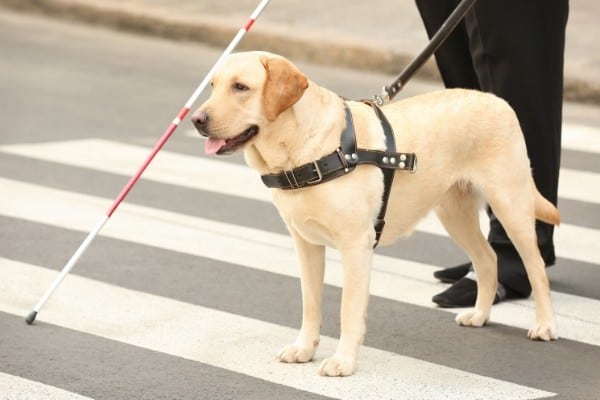In many ways, our relationship with our dogs is a partnership, a mutually dependent relationship grounded in love. We depend on our dogs for steady companionship, to alert us to danger, to enthusiastically welcome us home every day, to listen to our problems without judging, and in some cases, to protect us.
In turn, our dogs depend on us for food and shelter, health care, command, and social training to keep them safe, and, of course, affection.
For dogs trained for service roles such as guide dogs for the blind or visually impaired, that partnership goes even deeper. These special dogs are highly trained to assist and protect their handlers in a wide variety of situations, and the handlers grow to depend on their guide dogs for mobility and a more independent lifestyle.
Why are Labradors used as guide dogs? Labs are the most popular choice for guide dogs and excel in the role because, by nature, they are eager to please, gentle, loyal, friendly, highly trainable, and exceptionally intelligent, all necessary traits for guide dog work.
With only an estimated 5% of the blind community using guide dogs, you may not be very familiar with the tremendous work and effort that goes into raising just one specially trained guide dog. In the following, we’ll explain why Labradors are the most popular choice and have been for some time now.
Why Are Labradors Trained as Guide Dogs?
Not every dog is qualified to become a guide dog. Not every Labrador will make the cut either. In fact, the largest, most reputable breeding/training centers report that about only half of their puppies will complete the necessary training and go on to be partnered with a handler.
A guide dog’s job isn’t to lead the handler. Rather, the handler leads the dog and provides commands, and the dog guides the handler safely around any obstacles and hazards as the two navigate their path together in a perfect partnership.
A dog must meet certain criteria before being allowed to function as a full-time guide dog. It just so happens that Labradors tend to meet all the requirements much more frequently than other breeds do. Let’s examine each of the qualifying aspects of Labradors that make them a top choice for guide dog work.
Temperament
There are certain personality traits that are mandatory for guide dogs. To qualify, dogs must be friendly, non-aggressive, easy-going, loyal, capable of extreme focus, and able to remain calm and stick to their training even when faced with distractions.
Guide dogs also need to be forgiving when mistakes are made by the trainer or handler and be able to adapt well when ownership is transferred from the training facility to the new handler.
Labrador Retrievers usually have no trouble meeting these temperament qualifications. As a breed, they are famous for their extremely good attitudes, gentleness, and love of people. This relaxed, sociable personality coupled with a strong desire to please their owners makes Labs an ideal fit for guide dog work.
Intelligence and Discernment
While all dogs are smart to a certain degree, Labs are without a doubt very intelligent. As one of the ten smartest breeds, according to Dr. Stanley Coren, they are capable of learning up to 250 words and solving rather complex problems on their own. Definitely valuable skills for a guide dog to possess.
At times during a guide dog’s career, he’ll be forced to choose to obey his handler’s command or to ignore the given cue when safety is on the line. Guide dogs are trained in what’s called intelligent disobedience, and Labs are particularly skilled in this area, showing superb discernment in judgment-call situations.
For example, when coming upon a busy intersection, the handler will listen closely for signs that it’s safe to proceed and then command his dog to move forward. However, a discerning, well-trained dog will deliberately disobey the command if danger is still present. If the owner still tries to move forward, the dog will then use his body as a barrier to stop his handler.
Size
Being 21 ½ – 24 ½ inches tall, Labradors are the ideal height for the average size handler to comfortably hold onto the dog’s harness handle while walking and to touch their service dog without needing to bend too far down. Their size also enables them to maintain a steady, comfortable walking pace beside their handler.
Labs are also large enough that, if necessary, they’re capable of physically blocking their handler from moving forward into danger.
Guide dogs are trained to stop or maneuver around a hazard or obstacle in their handler’s path. If the handler, for some reason, ignores their service dog’s signal and proceeds forward toward the hazard, guide dogs will use their body to physically stop the handler from heading into danger, but they must be large enough to do so effectively.
Whereas a smaller guide might only cause their handler to trip when they attempt to block forward movement, a Labrador (average weight 55 -80 pounds) can stop their handler in their tracks without tripping them up and potentially save their life.
Trainability
By nature, Labrador Retrievers have an intense desire to please. They thrive when given plenty of praise for a job well done or a new command mastered. These cheerful people-pleasers are also very food motivated and learn quite quickly that doing what is asked of them is rewarded with two of their favorite things, praise, and treats.
Guide dogs typically spend the first year of their life with a volunteer family who teaches them basic commands and ensures that they are well socialized. After this, potential guide dogs are given back to the training facility where they begin intense training which continues for about four months.
If they’re destined to become a working dog, they are paired with a handler and the new pair will undergo several weeks of personalized training under the leadership of the trainer.
That is indeed a lot of training, but many Labradors easily rise to the challenge and seem to enjoy the work very much. This is a breed that was bred to work, so the fact that they don’t mind undergoing intensive training and being expected to perform a job comes as no surprise.
Ease of Grooming
Labrador Retrievers have a short, sleek double coat that does shed but is rather easy to maintain. The handler doesn’t need to worry about tangles or mats developing in areas missed during brushing. A quick brushing once or twice a week is all that’s needed to handle daily shedding and keep the coat healthy.
Are All Color Varieties of Labs Used as Guide Dogs?
Yellow, black, and chocolate Labradors all make excellent guide dogs if their individual temperament qualifies them and they show an interest in the work. Color is really irrelevant.
However, most Labrador guide dogs are yellow or black. There are several reasons for this.
Chocolate Labs, who at one point in time were routinely culled as pups, are now the most popular color and are in high demand both as family companions and for hunting work. They also tend to have shorter lifespans and slightly more health problems, such as ear infections and skin conditions, than black and yellow Labs do.
What Other Breeds Are Frequently Used As Guide Dogs?
While German Shepherd Dogs were the original breed used for this type of service work, over the years, Labradors have become the number one choice for guide dog work. In fact, one large breeding/training facility, Guiding Eyes for the Blind, reported that 92% of their guide dogs in training were Labrador Retrievers and only 8% were German Shepherds.
Golden Retrievers and Retriever crosses such as Labradoodles also are capable of becoming talented guide dogs, but are not trained nearly as often as Labradors are. Standard Poodles are occasionally requested for training for those who are allergic to most other breeds.
Other intelligent, easily trained breeds such as the Border Collie and the Australian Shepherd are sometimes trained for visually impaired individuals whose needs require a shorter dog.




![[Help Guide] How to Stop Dogs from Eating Cat Poop Quickly! (2024) Cat leaving litter box after going poop.](https://www.trendingbreeds.com/wp-content/uploads/2019/10/How-to-Stop-Dogs-From-Eating-Cat-Poop-150x150.jpg)
